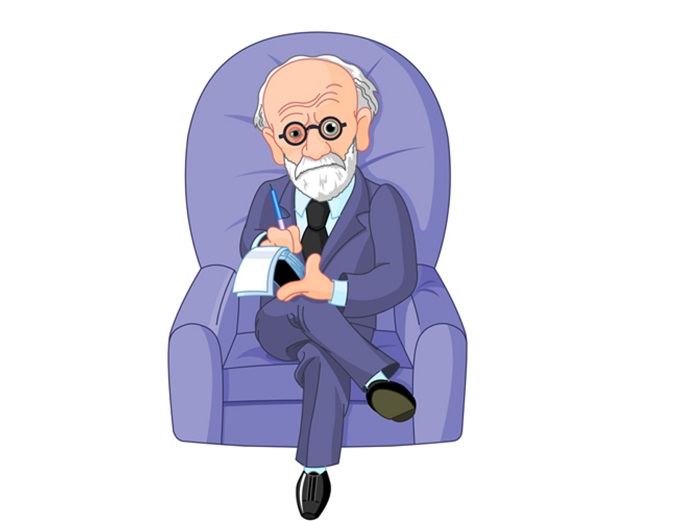
The Spirituality and Psychiatry Special Interest Group of the Royal College of Psychiatrists was founded just over 10 years ago by a number of Network Members, and now has over 2,000 members. Interestingly, this makes it the largest SIG within the College. Larry Culliford has been actively involved in this group and outlines in this article his view of the emerging psychospiritual paradigm and its implications. A review of his book will appear in the next issue.
Analogy
In the 1934 film, It Happened One Night, dramatic tension between the Clark Gable and Claudette Colbert characters depends on powerful mutual attractive forces being thwarted; yet the audience knows union must happen eventually. Spoilsports set up obstacles and, fuelled by previous disappointments, other circumstances give rise to false assumptions of incompatibility and fears of failure. The two people are restrained; but destiny is only delayed not denied.
This oft-repeated, boy meets girl tale, has a satisfying dénouement as attitudes change and ‘things happen’ to bring the pair together. Sometimes gradually, at other times through bursts of awakening insight, suspicions are overcome and realisation dawns: “They are meant for each other”.
So it is with psychology and spirituality. It must be so, if only because the latter is concerned with deep personal feelings of meaning and purpose, and of kinship with others. There may be setbacks but nothing can keep them apart indefinitely. The emergence of a holistic, ‘psycho-spiritual’ paradigm at last heralds now the approach of a satisfactory climax and promises a completely fresh start. In one sense nothing has changed. People are the same; but in another, a Copernican revolution in our understanding of ourselves and our place in the universe has arrived.
Paradigm
A paradigm is a way of seeing or construing the world which underlies the theories, operating principles, rules and methodologies of science during a particular period of history. Such a model incorporates values, assumptions and beliefs accepted by the scientific community and by those engaged in applying science, such as in the fields of health and social care. A paradigm shift, such as the one under discussion, involves a major conceptual change in both theory and practice. Just as Newtonian physics was surpassed by Einstein and quantum mechanics but not invalidated, so is psycho-spiritual psychology necessarily a development of the preceding secular-scientific approach.
The discipline of psychology, built largely around the idea of more complex phenomena being explained in terms of those that are simpler; the mind in terms of biology, for example; benefits also from the new intuitive and expansive, rather than primarily reductionist, approach. Spirituality, with a deeply personal central aspect, is better conceived as an adventure playground or theme park to explore than a laboratory specimen to dissect and analyse; and it is a theme park that we are all in already. [See Box 1 for some additional themes.]
Box 1. Some spiritual themes
(from Culliford 2010, pages 34 – 55)
Sacred unity/Non-dualism
Seamless unity of body, mind and soul
Life as a Journey/The holistic significance of death
Awe, Joy and Wonder
Reciprocity (You reap what you sow)/Avoiding conflict
Religion, God and the names of God/ The language of spirituality
Belief as a form of attachment
Faith, Wisdom and Love
Synchronicity/Different ways of experiencing time (Chronos and Kairos)
Transcendence, mysticism, accessing the source of knowledge/inspiration/virtue
Dimensions
The new paradigm depends on the principal characters or constructs being part of a seamlessly inter-connected family of five: the five dimensions of human experience – physical, biological, psychological, psycho-social and spiritual.
Diagram 1. Dimensions of human experience
(from Culliford 2010, page 49)

At first glance, these dimensions are organised in a linear hierarchy, but when the spiritual realm is conceived as the ultimate source and goal of matter and energy, a circular pattern also emerges. In so far as the spiritual dimension can be considered the binding and energising principle between the remaining four, it can be envisaged as having a central place too. These mutually reinforcing configurations can be seen in Diagram 1.
Holism
Wholeness is the principle characteristic of the spiritual dimension: indivisible, seamlessly interconnected, absolute, more than the sum of its parts. Symbolised by the yin-yang pictogram, a dynamic image of alternating dark and light, nothing is separate and nothing omitted. Opposites depend upon and define each other. Holism, whole, holy, heal and health: these words are all related.

According to the new paradigm, we human beings are each linked indissolubly to the spiritual dimension, to a higher plane, a sacred unity, to God or the Absolute, however each may conceive of and experience it. We are also seamlessly connected through it to each other, to nature and to the cosmos. It takes a poetic, rather than rational kind of logic to grasp this, a ‘both/and’ form of reasoning, rather than ‘either/or’. It takes a kind of spiritual awareness.
Pioneers
William James, one of the principal founders of modern psychology, originally published “The Varieties of Religious Experience” in 1902 (James 1982). After almost five hundred pages describing and defining deeply personal experiences, his short chapter of ‘Conclusions’ summarises these as follows:
- The visible world is part of a more spiritual universe from which it draws its chief significance.
- Union or harmony with that higher universe is our true end.
- Prayer or inner communion with the spirit thereof is a process wherein work is really done, and spiritual energy flows in and produces effects, psychological and material, within the phenomenal world.
- Religion brings a new zest, which adds itself like a gift to life, taking the form either of lyrical enchantment or of appeal to earnestness and heroism.
- It brings an assurance of safety and a temper of peace, and, in relation to others, a preponderance of loving affections. (James 1982, pages 485-6)
For ‘religion’ here we may safely substitute ‘spirituality’ or ‘spiritual awareness’.
Other early pioneers include Evelyn Underhill, Pierre Teilhard de Chardin, Carl Jung and Aldous Huxley, who differ from each other in both their backgrounds and approaches to the subject in ways that make the consistency and complementarity of their ideas particularly noteworthy. Independent thinkers, their writings can appear idiosyncratic and lacking in scientific rigour, and therefore have often been undervalued.
More recently James Fowler (1981), drawing specifically on the work of Jean Piaget, Erik Erikson and Lawrence Kohlberg, stands out as one of the first to try and systematise our understanding of human spiritual development according to six stages. John Swinton (2001), David Fontana (2003) and Victor Schermer (2003), are among those in the fields of psychology, psychiatry and psychotherapy whose writings cogently support a new psycho-spiritual paradigm.
By giving new focus to transition-points between Fowler’s stages, with new insights as to how the process of emotional healing leads to personal growth and maturity (in the face of threat and following loss), the template of this dynamic and elegant paradigm comes together.
Beginnings
Robert Coles (1992), Tobin Hart (2003), David Hay and Rebecca Nye (2006), Brendan Hyde (2008) and others have contributed to describing the spiritual lives of children. All attest to a natural, universal spiritual awareness in children from infancy until between ages eight to twelve. The observations they report support Schermer’s idea that each of us is born with a ‘pristine ego’ (a term borrowed from Donald Winnicot), the developmental seed of a true core or ‘spiritual self’ (sometimes referred to as the ‘Self’, ‘higher self’ or ‘soul’) that stays with us throughout life.
Hay and Nye report, however, that in contemporary UK culture children are encouraged to suppress and abandon any tendency towards spirituality and adopt a predominantly secular world-view. Teaching in schools about science, and the absence of a culturally sanctioned vocabulary or language of spirituality, are thought to be factors in this. By the teen years, spiritual awareness has withered and in many cases vanished from sight. As external influences grow, the spiritual self lies dormant, and is increasingly obscured by the ‘everyday ego’ (referred to also as simply ‘ego’ or as the ‘false self’).
Trajectories
The personal ‘everyday ego’ and the universally connected ‘spiritual self’ originate and are bound together like two light particles emanating from the same source. The early infant ego soon perceives and identifies with its body, feels pain, discomfort, frustration, abandonment, emptiness and insatiability. Needs associated with survival and desire come to the fore. These matters, necessarily involving attachment, threat and loss, are at the heart of human psychology.
The spiritual self is pitted from the outset against the body-bound, earth-bound, time-bound everyday ego of desire and survival. Nevertheless, its indivisible, holistic nature remains inviolable, however masked or otherwise hidden. This dissonance between the two, ego and self, throughout the six stages of spiritual development are shown in Diagram 2.
Diagram 2. Trajectories of faith through six stages of development, showing dissonance between ‘everyday ego’ and ‘spiritual self’
(from Culliford 2010, page 160)

Note how, by virtue of a strong persisting level of spiritual awareness, some people follow a low trajectory, with reduced dissonance between everyday ego and spiritual self; while others follow medium and high trajectories. As the illustration indicates, when ‘something happens’; something uniquely significant for each individual, in a way that can be hard to describe; a person can move in either direction from one plane or trajectory to another. Put simply, spiritual maturity involves moving forward through the stages, reducing the ego-self split.
A majority of adults have been found in surveys to occupy stages three to five, but people advance along the different trajectories at different speeds. Development, especially after childhood, is not necessarily age-related. This explains how people fail (at least for a time) to progress beyond the earlier stages. Failure to progress is about slowing down or being held back, rather than about lacking growth potential.
The Stages
Revised names for Fowler’s six stages reflect their main characteristics. [See Box 2.] Self-awareness marks the start of the ‘egocentric’ Stage One. Later, during the ‘conditioning’ Stage Two, young people take on the stories, beliefs and observances that symbolise belonging to their community, tending to give literal interpretations to religious and historical narratives and folk tales, being literal also in their understanding of moral rules and attitudes.
Box 2. New Names for Fowler’s Six Stages
(from Culliford 2010, page 23)
(Stage 0. Undifferentiated faith – Infancy)
Stage 1. Intuitive-Projective faith – Egocentric Stage
Stage 2. Mythic-Literal faith – Conditioning Stage
Stage 3. Synthetic-Conventional faith – Conformist Stage
Stage 4. Individuative-Reflective faith – Individual Stage
Stage 5. Conjunctive faith – Integration Stage
Stage 6. Universalising faith – Teaching and Healing Stage
From adolescence onwards, people are motivated by two common, but apparently opposing, drives:
a) to conform and belong to a group,
b) to experience oneself as independent-minded, as a separate person.
‘Conformist’ Stage Three is dominated by the first of these. There is a premium on wanting to feel stable and safe. People identify themselves as belonging to family, tribal or social groupings and so define their allegiances according to a range of criteria that include, for example, gender, place of origin, nationality, race, language (including accent or dialect), skin colour, current place (home and neighbourhood), social class, sexual orientation, religious (or non-religious) affiliation, and political persuasion.
The second of the two drives takes precedence in the more adventurous ‘Individual’ Stage Four. This involves leaving once precious people, places and ideas behind, seeking new allegiances, and may involve rejection and solitude in both directions: where we are coming from and where we are going. Stage Four necessarily, therefore, involves a degree of sacrifice, facing threats and losses, but does provide many with their only pathway towards significant personal and spiritual maturity. Adversity has here become a requirement of spiritual growth.
It is possible to think and act independently while remaining broadly conformist within a group, but only inside limits set by the group. The less tolerant the group’s attitudes, the more rigid its rules and belief system, the more difficult this will be. Opposition between the two drives can only be fully resolved in the more mature ‘integration’ Stage Five and ‘teaching and healing’ Stage Six.
Transition-Points
Transition between stages involves letting go of attachments and aversions, of entrenched likes and dislikes directed towards people, places, objects, wealth, activities, ideas, ideologies and so on. It requires release from preferences and pet hates alike. Most difficult, therefore, is moving on from Stage Three, which is defined (and in which people define themselves) by degrees of exclusivity, by a predominantly partisan, divisive, dualistic, ‘us and them’, ‘for and against’, ‘right and wrong’ mentality.
This is a natural, but unstable level of personal psychological development, and a socially divisive one with frequently destructive consequences. Those who begin to understand this point; who are therefore already thinking for themselves, independently of the family, tribal or social group to which they may hitherto have given allegiance; often experience the full range of painful emotions: bewilderment, doubt and anxiety associated with threatened losses; anger associated with resisting threats and loss; shame, guilt and sadness associated with being no longer able to avoid or prevent loss.
A Double Spectrum of Emotions
Attachment (wanting something, possessiveness) and its correlate, aversion (not-wanting something, seeking to avoid or destroy), are the preconditions of emotional pain. The psychological antidote to these drives and their emotional consequences involves finding satisfaction, contentment.
Contentment is associated with emotional health and healing. It involves the ability to acknowledge threats and losses, then to relinquish resistance to them. Passage through the spectrum of painful emotions thus becomes easier. Reaching sadness, and experiencing the catharsis of tears associated with it, allows the natural healing process to advance to completion.
In this way, emotional energy invested in attachments gets released from the system, and painful feelings mutate spontaneously into their pain-free counterparts. Bewilderment becomes clarity, doubt becomes confidence, anxiety becomes calm, anger turns to acceptance, shame and guilt turn to feelings of worth, purity and innocence, and sadness finally becomes joy. [See Box 3]
Box 3. Spectrum of Emotions – the bi-modal set
(from Culliford 2010, page 22)
Painful Pain-free
Wanting (both desire and aversion) – Contentment
Bewilderment (confusion) – Clarity
Anxiety – Calm
Doubt – Confidence
Anger – Acceptance
Shame – Worth (self-esteem)
Guilt – Innocence (purity)
Sadness – Happiness (joy)
A complication, according to temperament, is that people naturally develop attachments and aversions also to their emotions. Some enjoy, for example, the sensation of power and the feeling of being in the right often associated with anger. They may experience this emotion as a preference, to avoid or mask less comfortable sensations of doubt, guilt or shame. They therefore make progress when a degree of aversion to anger develops. Feeling in the right usually also involves a strong aversion to, and suppression of, both doubt and confusion.
Other people, for example, avoid anger, in themselves and other people, because of the excessive anxiety it arouses. They will therefore make progress by facilitating their anger, in a safe environment, rather than suppressing it. Both temperamental types experience difficulties in allowing the natural emotional healing process to flow towards healing and the restoration of equanimity. Many additional examples of this type of feedback-loop hindrance to the natural and healthy flow of emotions could be cited. (See Whiteside, 2001)
Growth
An essential point concerns the healing process being accompanied by permanent gain in the form of personal growth. After weathering a significant loss, people are left able to experience a wider range of both painful and pain-free emotions, and in greater intensities than before. They therefore find new courage and hope for the future; and they develop increasing emotional resilience, rebounding more quickly to a calm level of equanimity after further setbacks. Generally less fearful, they tend to live with greater joy, spontaneity and freedom than before.
This is why, after an episode of emotional trauma, for example brought on by severe illness or bereavement, someone might say they would not want to go through it again, but were somehow glad that it happened. This affirms a principle of spirituality, that there can be purpose in suffering. Later, with wisdom; such as when leaving the isolation of Stage Four and entering Stage Five; letting go of attachments may occasion the catharsis of laughter, rather than tears. One of the gains here is humility.
Spiritual Maturity
The universal Stage Five is distinguished by a growing and deeply personal awareness of connectedness to the spiritual dimension, and through it to an inviolable and sacred continuity throughout the universe, binding each person to nature and to one-another. The new group we may have been searching for during Stage Four turns out not to be partisan, but to include everyone, the whole of humanity. Stage Five therefore involves a renewed sense of kinship, and with this the awakening of a powerful sense of social concern and compassion.
As we grow in this new level of awareness, the dissonance between everyday ego and spiritual self diminishes. The balance between worldly and spiritual values shifts naturally in favour of the latter. A person prefers honesty, trust, kindness, generosity, tolerance, patience, perseverance, discernment, humility, courage, compassion, wisdom, beauty, hope and selfless love, for example, rather than a relentless appetite for power, wealth, fame and success.
Some people achieve a high degree of sanctity, growing to embody these virtues so spontaneously and completely as to become natural teachers and healers. These are the relatively few who have so far entered Stage Six.
Spiritual Practices and Skills
The question arises as to what a person can do to lower their spiritual trajectory, to improve their chances of spiritual growth through the Stages towards maturity. The answer involves engaging regularly in spiritual practices, in acquiring and developing spiritual skills. [See Box 4]
Box 4. Some Spiritual Skills (from Culliford 2010, pages 201-2)
- Being able to rest, relax and create a still, peaceful state of mind.
This is the key skill, and the reason why silent prayer, meditation practice and ‘stilling’, which have much in common, are so useful and effective. There are sound neuro-biological reasons for this. (Nataraja, 2008) These three comparable activities form a sound basis for acquiring other skills listed below.
- Remaining focused in the present, staying alert, unhurried and attentive.
- Going deeper into the stillness and observing one’s emerging thoughts and feelings with emotional stability, in a way that carries over into everyday life.
- Being honestly and sincerely self-reflective, taking responsibility for every thought, word and action.
- Using the capacity for deep reflection to connect with one’s spiritual essence and values.
- Developing compassion and an extensive capacity for direct empathic communication with others.
- Emotional resilience: having the courage to witness and endure distress while sustaining an attitude of hope.
- Being able to give without feeling drained.
- Being able to grieve and let go.
These skills are interconnected and mutually reinforcing. Key elements in acquiring and enhancing them are stillness, silence and solitude. These three go together, and are established components of spiritual exercises in the more mystical Christian, Islamic (Sufi), Jewish, Buddhist and Hindu religious traditions. Religious practices that foster spiritual development include meditation and prayer, reading scripture, ritual worship, chanting, dance and other uses of sacred music, going on pilgrimages and retreats.
These major world religions are treasure-houses of spiritual wisdom. Nevertheless, many spiritual practices that are not specifically religious are engaged in by many people to their significant benefit. For example, people who do not read scripture, might regularly read great literature, poetry or philosophy. Many engage similarly profitably with inspired secular music.
Other ‘secular’ spiritual practices include: acts of compassion; ‘stilling’; contemplation; yoga, tai chi and similar disciplined activities; maintaining physical health; engaging with and enjoying nature; appreciation of the arts and engaging in creative activities; maintaining stable family relationships and friendships; and, co-operative group or team activities (sporting, recreational or other), involving a special quality of fellowship. Sometimes these practices may be combined, for example through gardening or keeping an allotment, by taking the dog for a daily walk, or through joining a choir or rambling group.
Having been conditioned to underplay it, very many people fulfil spiritual needs regularly in these ways without necessarily calling it such or fully recognising that this is a vital aspect of their lives. As the new paradigm becomes more widely influential, this is certain to change.
New York psychiatrist, Paul De Bell, for example, advises using rational techniques to detect and decipher feedback from the spiritual dimension. (De Bell, 2009). Stephen Post, a professor of bio-ethics and family medicine in Cleveland (together with science writer Jill Neimark; Post & Neimark 2007), has written about ‘Ten ways of giving’, each the subject of persuasive research collated at the Institute for Research on unlimited Love, founded in 2001, attesting to their benefits. Post and Neimark provide guidance for readers on how to assess and improve in each of the recommended ten parameters listed in Box 5.
Box 5. Ten Ways of Giving (from Post & Neimark 2007)
The way of celebration: — gratitude
The way of generativity: — helping others grow
The way of forgiveness: — set yourself free
The way of courage: — speak up, speak out
The way of humour: — connect with joy
The way of respect: — look deeper and find value
The way of compassion: — feel for others
The way of loyalty: — love across time
The way of listening: — offer deep presence
The way of creativity: — invent and innovate
The new psycho-spiritual paradigm for psychology addresses how the spiritual dimension mediates the myriad, complex connections between personal and social psychology. The principle of reciprocity, embedded centrally within the paradigm, invites active personal participation in a spiritual quest or journey towards maturity and wisdom; and that explains why authors like these provide guidance, seeking to point out effective pathways to growth.
The search for objectivity associated with the former secular, scientific model of psychology is not redundant, but can now profitably be complemented by a suitably meditative or contemplative methodology to achieve deep subjective insights that are equally valid and reliable, and may prove of superior value.
Conclusion
This has been a very brief overview of the holistic or ‘psycho-spiritual’ paradigm for psychology now emerging.
Spirituality knows no boundaries and such a paradigm, originating in the fields of personal and social psychology, has relevance in every sphere of human endeavour, perhaps particularly education, health and mental health care, but also throughout science, in commerce, politics and international relations, also, through nurturing creativity, in the arts. By promoting reverence, it could also revitalise interest in religions.
Some people have known all along that psychology and spirituality are meant for each other. The night is passing. Something has happened to allow news of this highly compatible partnership to reach many more. Daylight is already shining on a workable, up-to-date paradigm. Excessive good fortune awaits when it is fully grasped, expounded, lived out and so brought to fruition; and this is happening now.
References
Coles, Robert (1992) The Spiritual Life of Children, HarperCollins, London.
Culliford, Larry (2010) The Psychology of Spirituality: an introduction. Jessica Kingsley, London.
De Bell, Paul (2009) Decoding the Spiritual Messages of Everyday Life: How Life Shows Us What We Need To Know. Sterling Ethos, New York.
Fontana, David (2003) Psychology, Religion and Spirituality. BPS Blackwell, Oxford.
Fowler, James (1981) Stages of Faith: The Psychology of Human Development and the Quest for Meaning. HarperSanFrancisco, San Francisco.
Hart, Tobin (2003) The Secret Spiritual World of Children. Inner Ocean, Maui, Hawaii.
Hay, David & Nye, Rebecca (2006) The Spirit of the Child (revised edition). Jessica Kingsley, London and New York.
Hyde, Brendan (2008) Children and Spirituality: Searching for meaning and connectedness. Jessica Kingsley, London & New York.
James, William (1982) The Varieties of Religious Experience: a study in human nature. Penguin American Library Edition, London.
Nataraja, Shanida (2008) The Blissful Brain: Neuroscience and Proof of the Power of Meditation. Gaia, London.
Post, Stephen & Neimark, Jill (2007) Why Good Things Happen to Good People: How to live a longer, healthier, happier life by the simple act of giving. Broadway Books, New York.
Schermer, Victor L. (2003) Spirit & Psyche: a new paradigm for psychology, psychoanalysis and psychotherapy, Jessica Kingsley, London & New York.
Swinton, John (2001) Spirituality and Mental Health Care: rediscovering a forgotten dimension. Jessica Kingsley, London & New York.
Whiteside, Patrick (2001) Happiness: The 30 Day Guide. Rider Books, London.




